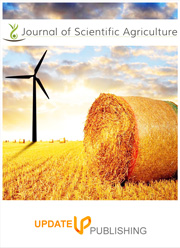Genetic analysis of yield related traits in landrace × commercial watermelon hybrids
DOI:
https://doi.org/10.25081/jsa.2022.v6.7477Keywords:
Citrullus lanatus, Combining ability, Land races, Path analysisAbstract
Watermelon [Citrullus lanatus var lanatus L.] is a major xerophytic crop originating in Africa especially grown in subtropical and tropical parts of the world. However, few adapted varieties are available to promote greater yield and make watermelon a viable commercial crop of choice. Path analysis and combining ability was carried out for yield related traits among three popular local landraces; Landrace1, Landrace 2 and Landrace 3 collected in Zimbabwe and three commercial watermelon varieties ‘Congo’, ‘Charleston Grey’ and ‘Crimson Sweet’ in plots arranged in an RCBD replicated 3 times. A complete diallel mating design was used to generate 36 F1 genotypes which together with the parents were evaluated for several quantitate traits. Data on correlations, path analysis, GCA and SCA between fruit yield and other traits were computed using Microsoft Excel and GenStat 17. Individual fruit weight (FIW) and the number of fruits per plant (NF) were found to be significantly linked with final fruit yield. Significant positive correlations were also observed on NF and number of female flowers (NFF), number of vines (NV), and FIW and these traits could be recommended as reliable selection indicators for creating high yielding watermelon genotypes. Path analysis showed that FIW and NF were the most important contributors to watermelon yield. GCA and SCA effects were significant and positive for yield which indicates that the traits are controlled by both additive and non-additive genes. ‘Crimson Sweet’ and ‘Landrace 1’ were the best pollen sources whereas ‘Landrace 1’ and ‘Landrace 2’ were the highest yielders when used as female parents. Overall, results from this study identified usable yield related proxies and need to incorporate local landraces germplasm in watermelon improvement.
Downloads
References
Bahari, M., Rafii, M. Y., Saleh, G. B., & Latif, M. A. (2012). Combining ability analysis in complete diallel cross of Watermelon [Citrullus lanatus (Thunb.) Matsum. and Nakai].The Scientific World Journal, 543158. https://doi.org/10.1100/2012/543158
Correa, E., Malla, S. C. K., & Avila, C. (2020). Evaluation of genotypes and association of traits in watermelon across two Southern Texas locations. Horticulturae, 6(4), 67. https://doi.org/10.3390/horticulturae6040067
Dube, J., Ddamulira, G., & Maphosa, M. (2021). Watermelon production in Africa: Challenges and opportunities. International Journal for Vegetable Science, 27(3), 211-219. https://doi.org/10.1080/19315260.2020.1716128
Gbotto, A. A., Koffi, K. K., Bi, N. D. F., Bi, S. T. D., Tro, H. H., Baudoin, J., & Bi, I. A. Z. (2016). Morphological diversity in oleaginous watermelon (Citrullus mucosospermus) from the Nangui Abrogoua University germplasm collection. African Journal of Biotechnology, 15(21), 917–929. https://doi.org/10.5897/AJB2015.14701
Griffing, B. (1956). Concept of general and specific combining ability in relation to diallel
cross systems. Australian Journal of Biological Science, 9, 463–493. https://doi.org/10.1071/BI9560463
Mujaju, C., & Nybom, H. (2011). Local level assessment of watermelon genetic diversity in a village in Masvingo province, Zimbabwe, structure and dynamic landraces on farm. African Journal of Agricultural Research, 6(27), 5822-5834. https://doi.org/10.5897/AJAR11.100
Mulyani, P., & Waluyo, B. (2020). Correlation Analysis Between Yield Component Traits and Yield of Watermelon Genotypes (Citrullus lanatus). Agrosainstek, 4(1), 41-48. https://doi.org/10.33019/agrosainstek.v4i1.86
Nisha, S., Sreelathakumary, I., & Celine, V. (2018). Variability, interrelationship and path coefficient studies in watermelon. Indian Journal of Horticulture, 75(4), 619-624. https://doi.org/10.5958/0974-0112.2018.00103.2
Nascimento, T. L., Souza, F. F., Dias, S. C. R., & Silva, F. E. (2019). Watermelon general and specific combining ability. Comunicata Scientiae, 10(1), 132-140. https://doi.org/10.14295/cs.v10i1.2899
Shamuyarira, K. W., Shimelis, H., Mathew, I., & Tsilo, T. J. (2019) Correlation and Path Coefficient Analysis in Drought- tolerant bread wheat populations. South African Journal of Plant and Soil, 36(5), 1-8. https://doi.org/10.1080/02571862.2019.1626500
Souza, F. F., Gama, F. C., & Queiroz, M.A. (2004). Combining ability analysis in diallel crosses among three watermelon genotypes. Horticultural Brasileira, Brasilia, 22(4), 789–793. https://doi.org/10.1590/S0102-05362004000400025
Published
How to Cite
Issue
Section
Copyright (c) 2022 T. Nyurura, M. Maphosa

This work is licensed under a Creative Commons Attribution-NonCommercial-NoDerivatives 4.0 International License.



 .
.